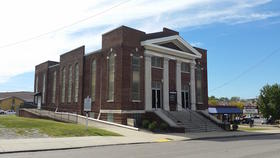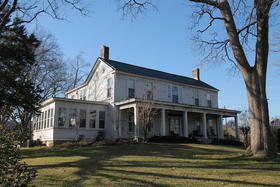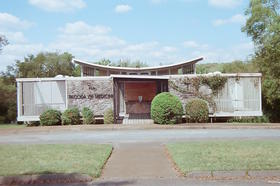
A heightened sense of urgency accompanied today’s announcement of the “Nashville Nine” list of endangered historic properties.
Just one day before the non-profit Historic Nashville Inc. revealed its list, a marquee building identified on last year’s list — the Trail West building on Lower Broadway — was abruptly torn down by its owners.
Preservationists couldn’t help but call attention to the timing, saying the loss of the Trail West department store “strengthens the need for a strong preservation advocacy voice in the city.” The building was going to be on this year’s list until its demolition, said
Brian
Tibbs
, Historic Nashville president.
“
It’s gone now. That piece of history is no longer,
” Tibbs said
.
“We can’t talk about how we can save that anymore. Only thing we can talk about now is ‘What if?’ and ‘Why if?’ …
Let’s not have this same story about any of these properties next year.”
Historic Nashville Inc. tries to provide that voice, although its list of endangered properties doesn’t provide any specific protections. Instead, the group tries to bring attention to properties threatened by demolition, neglect, or development, and then works to encourage repairs or purchases from preservation-minded buyers.
The 2015 “Nashville Nine” list of endangered buildings and properties (details below):
- The Pagoda of Medicine
- Lifeway Christian Resources campus
- Capers Memorial CME Church
- Col. Tom Parker House
- All historic apartment buildings from the early 1900s
- The Whites Creek rural community and historic district
- The Chestnut Hill neighborhood
- The Music Row neighborhood
- Rural cemeteries of Davidson County.
The list was announced Tuesday morning at the preserved Marathon Village, where
“
American Pickers
“
TV star and preservationist Mike Wolfe spoke on behalf of the non-profit and its endeavors.
He blamed
“
big egos
“
and profits for gutting historical properties.
“The pages of Nashville’s book of history are literally being tore out,
” he said.
Capers CME Memorial Church
319
15th Avenue North
Built in 1925

This historic African-American church
was designed by a noted Nashville-based African-American architectural firm McKissack & McKissak and built in 1925. It is considered significant for both its history and architecture but is threatened by deferred maintenance and water infiltration damage.
Rural Cemeteries in Davidson County

The non-profit named all of the county’s small, rural cemeteries — some dating to the 1700s — as endangered by development and neglect.
Some gravestones are said to be the only surviving vestiges of the time period, but they have occasionally been removed by developers without permits.
Chestnut Hill Neighborhood

One of the city’s most rapidly redeveloping neighborhoods leaves
some residents worried about teardowns of original historic homes that date to the late 1800s.
And one of the neighborhood landmarks, the Layman Drug Store,
was sold to developers in March and could be demolished and redeveloped.
Whites Creek Rural Historic District
Whites Creeks Pike from Old Hickory Boulevard to Buena
Vista
Constructed from the early 1800s

Whites Creek is the location of Nashville’s only rural historic district listed on the National Register of Historic Places. The 157-acre area contains buildings constructed between the 1830s and early 1900s.
Early settlers including Frederick Stump lived in Whites Creek, as well as the notorious Jesse James.
The
area has been under pressure for suburban-style residential development.
Colonel Tom Parker House
1215 Gallatin Pike South, Madison
Built in 1935

This 80-year-old stone building is the former home and office of Col.
Tom Parker, the legendary manager for Elvis Presley, Hank Snow and Eddy Arnold. It’s one of Tennessee’s few remaining buildings with a direct tie to Presley, who stayed there while recording on Music Row. Owners Steve and Jo Ann North
have sought a preservation-friendly buyer, but have been unsuccessful for several years, leaving the building threatened by development pressures.
Historic apartment buildings along West End and Elliston Place
Built from 1900-1925

Upscale apartments, such as The Westboro, have been under threat of demolition in recent years amid redevelopments in bustling West Nashville, but preservationists admire their architecture and character, including hardwood floors, fireplaces, moldings, and tilework.
Lifeway Christian Resources Campus
Broadway to Church Street from 9th Ave. N. to the Gulch
Buildings from 1913

Lifeway Christian Resources, the publishing arm of the Nashville-based Southern Baptist
Convention, has operated at this nine-building campus for 120 years and is significant for its architecture and meaning to the city’s faith and publishing histories.
Buildings on the campus include the Frost Building, a five-story Neoclassical Revival building constructed in 1913 and listed on the National Register of Historic Places, and the Sullivan Tower, an 11-story Art Deco high-rise constructed before 1953. Both were designed by local architectural firm Hart Freeland Roberts.
The campus is
in the process of being sold to developers.
Pagoda of Medicine
707 Young’s Lane
Built in 1963

The Pagoda of Medicine is a mid-century modern building originally owned by Dr. Carl
Ashley Dent, an African-American physician and missionary, and its design is attributed to notable African-American architect Leon Quincy Jackson. Jackson studied under an architect who followed in a line from Frank Lloyd Wright. The former doctor’s office and assisted living facility has been vacant since 2008. While it retains its original architectural integrity, it has suffered water damage and vandalism.
Music Row Neighborhood
Between 16th and 20th Avenues, from Division and Demonbreun Streets to
Belmont University

Billed as the only neighborhood in America where songs are written and recorded, publishing deals cut, royalties paid, guitars repaired, tours arranged, music broadcasted, and videos taped — all on a few neighboring blocks —
preservationists have scrambled to preserve Music Row.
Dozens of buildings have been demolished in the past three years, with others scheduled for the wrecking ball, says Historic Nashville Inc.


